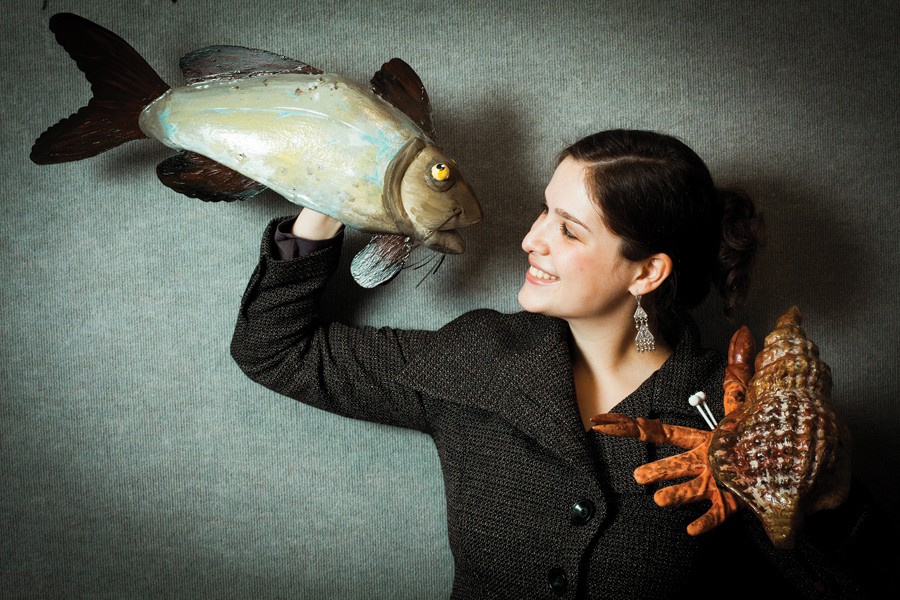As a medical humanities undergraduate at Northwestern University, Maya Nadison combined her love of theater arts with an interest in public health to create an anti-bullying puppet show. She took the show to Tokyo when she studied Bunraku puppetry at the National Theatre of Japan. Now a fourth-year doctoral candidate in the Bloomberg School of Public Health's Department of Mental Health, she has fashioned a sexual abuse awareness intervention for Baltimore City schools that also uses puppets.
"One of the reasons why I came [to Johns Hopkins] is because I want to use theater for child health promotion," Nadison says, reaching into her bag and taking out a large flying insect puppet that she designed and fabricated. The wings are hand-painted foam, the legs television cable she stripped and coated in liquid rubber.
She has created 15 insects, as well as a narrative framework, for a project that uses fun facts about the insect world to talk about sexual abuse and personal safety. Consider the firefly, which uses bioluminescence to light up. Males do this when they are ready to mate. "What's even more interesting is that when the female agrees to the mating, she also lights up," Nadison says. "So [the firefly puppet] leads to a discussion about consensual sex." Or consider the Madagascar hissing cockroach. "It doesn't have wings to fly away," she says. "But when it feels attacked it produces a loud hissing sound. So that's all about if you can't escape a situation, there are ways to make yourself heard." She describes the project as a mix of educational theater, child health, and clinical work. "The animal world and anthropomorphism are very powerful tools when talking about these topics because the child can remove himself from what really happened."
The need for sexual abuse interventions is there. Abuse services centers estimate that one in four girls and one in six boys will be sexually abused by the time they are 18. About 95 percent of victims know their abusers. Only about 10 percent of these incidents are reported. The statistics represent what researchers can determine from current data, which come from reports from law enforcement, social services, and hospitals of events that required response, plus additional figures from adults reporting past experiences. Other than some general risk factors—among others, being a girl (though boys are sexually abused as well), being a preadolescent or early adolescent, having a stepfather—predictors have been hard to identify. Incidence of childhood sexual abuse stretches across class and ethnicity.
When the data on abuse are this diffuse, determining how best to measure prevention strategies presents its own challenges. Nadison has witnessed firsthand how well some students respond to her puppets. But to demonstrate how effective her projects are, she needs to develop a way to evaluate them—the persistent conundrum of arts-based interventions. "Evaluation is important, and I'm having trouble with that," Nadison admits. The nature of the abuse compounds her difficulty. "Yes, theoretically it would be nice to have a survey," Nadison says, citing one common evaluative instrument. "But you're talking about sexual abuse. It's not as if you're talking about a nutrition program and you ask kids how many carrots they ate."
Her research grants, from Johns Hopkins' Urban Health Institute and the Albert Schweitzer Fellowship, fund her current partnership with the Baltimore Child Abuse Center, through which she works with middle school students to stage a show about personal safety that includes sexual abuse awareness. Nadison brings her sewing machine and puppetry materials to the school, and, paired with a social worker, she helps 12 students make characters and develop a storyline.
Eventually, she envisions a children's book and an accompanying puppetry performance that can be taken into schools as a platform for discussion. Turning those experiences into evidence-based research that can be acted upon isn't easy, though. Childhood sexual abuse is devastating, and the human desire to help in any way possible can conflict with the rational mind's efforts to systemically develop the best practices. "Through the Child Abuse Center I've heard a 3-year-old talk about her uncle abusing her and she didn't even know her body parts," Nadison says. "So I have to keep my expectations realistic. Maybe some of these kids who were abused didn't go tell anybody. And if the project inspires them to go tell somebody, maybe they'll get the help they need."
Posted in Health, Arts+Culture
Tagged public health, theater, drama, child abuse








